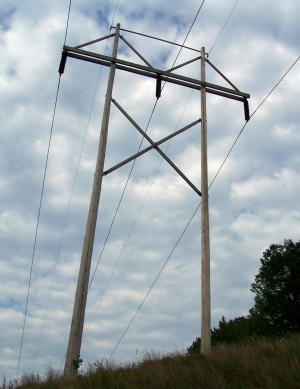CONTENTIOUS $3 BILLION POWER LINE CROSSING REGION - Will West Virginians Get Short End?

Current high-voltage line crossing Calhoun near Hur
is on wooden poles - proposed right-of-way width to be
increased an additional 200' (clearing 25 acres per mile)with much larger steel towers,
some photos show them to be 177' feet high x 82' wide, clearing
(Hur Herald Photo)
By Bob Weaver
The greater Kanawha County region was smitten with blue haze again this week, with most state regulators saying the haze is caused from emissions from the John Amos power plant in Putnam County.
Which raises questions about the increased demands being placed on the Amos plant to produce electric for the northeast grid, with the burning of nearby coal resources.
A 765-kilovolt $3 billion power line will run 244 miles from the Amos facility near St. Albans into central Maryland, cutting across a number of West Virginia counties, including Calhoun.
The AEP project will be submitted to the state's Public Service Commission late this year.
"The issues surrounding the project will likely take-up most of 2009," said the PSC's public advocate Brian Harris.
"The benefit to West Virginia is not as great as other states," said Harris, "but increasing the strength of the power grid is a big benefit."
A contentious issue is related to a federal law that says all states the line crosses must share in construction costs, although the state would be among the smallest users.
Most of the power will be consumed by urban eastern areas, far from the West Virginia hills and the Amos plant, which will be consuming huge amounts of coal which produces toxic emissions.
It is yet to be known how much of the $3 billion construction cost will be billed to West Virginia users.
West Virginia has always been a major exporter of electric power because of the coal industry.
Historically, state residents have been tolerant of the industry because it has meant jobs, jobs that have drastically declined with the advent of mountaintop removal and improved technology.
Bob Hamburg, an Orma resident, called coal-fired electric generation another "sacrifice" by West Virginians, likening it to the movement by northeast cities to dump their garbage in the Mountain State, trying to convince residents it is "economic development."
Hamburg, in a letter to the editor of the Times-Record, concluded rejection of the high-voltage power generated by coal could be a major contribution in limiting fossil fuel emissions.
Steve Gormezano of Harmony believes there are health issues close to the high-voltage lines, saying "A 345-kilovolt line will light up a fluorescent bulb under the wires," although there is inconclusive evidence of what electromagnetic radiation will do to human beings.
Gormezano believes, now is the time to change direction with the nation's energy, away from fossil fuel.
President George Bush, appearing in West Virginia at the Greenbrier this week, assured state coal producers their product would continue to play a major role in energy production.
Coal producer Buck Harless, who was the state's biggest contributor to the Bush campaign, introduced the President.
The Bush administration has given the electric company imminent domain in 41 of West Virginia's 55 counties in support of the Amos project, although company reps insist they will attempt to use current right-of-ways or select routes with the least impact.
This week, Michael Morris, American Electric Power's chairman, president and chief executive officer, said the company will fix the blue haze problem which continues to haunt the Kanawha Valley.
"If we're the culprit, we'll fix it," Morris said, at the meeting of the West Virginia Coal Association's annual meeting, which President Bush attended.